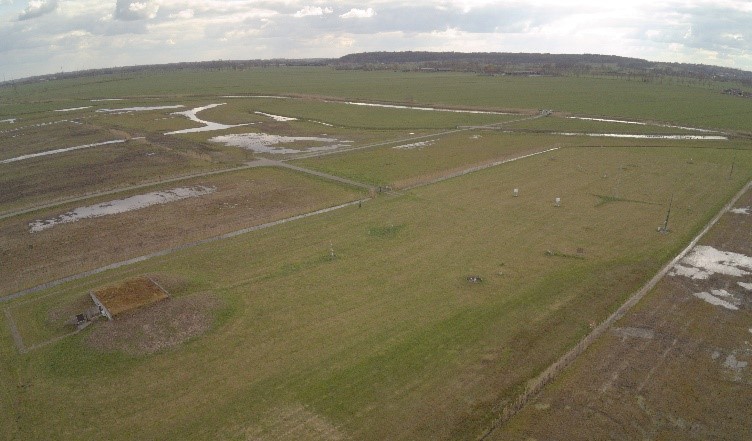
Features
- Undisturbed rural grassland site in the centre of The Netherlands, representative for the rural background climate.
- Very low horizon obstruction, far away from forests, motorways or built up space.
- Radiation balance including direct and diffuse radiation observations, longest global radiation record of The Netherlands
- Energy balance, turbulent flux observations, GHG flux

Background
Wageningen University started its first meteorological observations since 1919. Due to urban expansion the station was relocated twice. The Veenkampen weather station became operational in 2010 and replaces the former Haarweg station. It is located in an open grassland area 5.7 m above NAP at latitude N51.981 Longitude E5.620. The soil profile consists of a thick clay layer of about 0.6 m on the east side and gradually reducing to zero at the west side. The clay is overlaying a thick peat layer. The area surrounding the weather station in protected grassland nature reserve since 2020.
Rationale for including in Ruisdael Observatory
Developing and improving high resolution modelling of The Netherlands requires several well defined reference stations. The Netherlands is very densely populated and it is unique to have Veenkampen at a very central and rural undisturbed location so far away from built up areas, motorways or wind generators. It is just 10 km south of the geographical center of The Netherlands. Veenkampen is complementary to Cabauw with different hydrology, water management and the wider surroundings showing a larger soil type variation. Therefore it is important to have additional extensive observations of the separate components of the surface energy balance terms with detailed shortwave and thermal radiation, and turbulent flux observations from continuous eddy covariance measurements. Together with Cabauw and Loobos it forms a valuable triangular observation network in the center of The Netherlands.
Continuous measurements of the full energy balance, i.e. sensible and latent heat flux, soil heat flux, radiation balance (shortwave and thermal). During intensive observation periods radio soundings of the lower atmosphere (up to 5 km) traverse observations with a tricycle weather station. Continuous observations of black carbon air pollution. Soil respiration observations will be added in 2021. Continuous measurements of groundwater table, soil moisture, soil temperature profile up to 1.5 m depth. Separate measurements of direct and diffuse solar radiation. Measurement averaging interval 1 minute. Raw turbulence measurements available at 20 Hz.

Data can be found here.
Coordinator
Bert Heusinkveld, Wageningen University, Meteorology and Air Quality Section.
